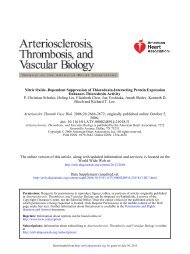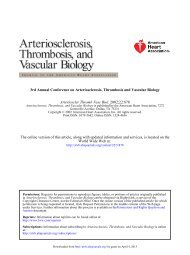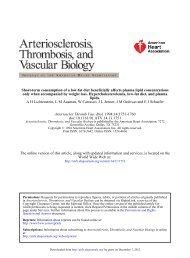CX3CR1 Deficiency Confers Protection From Intimal Hyperplasia ...
CX3CR1 Deficiency Confers Protection From Intimal Hyperplasia ...
CX3CR1 Deficiency Confers Protection From Intimal Hyperplasia ...
Create successful ePaper yourself
Turn your PDF publications into a flip-book with our unique Google optimized e-Paper software.
2062 Arterioscler Thromb Vasc Biol. September 2006<br />
10. Ghilardi G, Biondi ML, Turri O, Guagnellini E, Scorza R. Internal carotid<br />
artery occlusive disease and polymorphisms of fractalkine receptor<br />
<strong>CX3CR1</strong>: a genetic risk factor. Stroke. 2004;35:1276–1279.<br />
11. Harrison JK, Jiang Y, Wees EA, Salafranca MN, Liang HX, Feng L,<br />
Belardinelli L. Inflammatory agents regulate in vivo expression of fractalkine<br />
in endothelial cells of the rat heart. J Leukoc Biol. 1999;66:<br />
937–944.<br />
12. Garton KJ, Gough PJ, Blobel CP, Murphy G, Greaves DR, Dempsey PJ,<br />
Raines EW. Tumor necrosis factor-alpha-converting enzyme (ADAM17)<br />
mediates the cleavage and shedding of fractalkine (CX3CL1). J Biol<br />
Chem. 2001;276:37993–38001.<br />
13. Tsou CL, Haskell CA, Charo IF. Tumor necrosis factor-alpha-converting<br />
enzyme mediates the inducible cleavage of fractalkine. J Biol Chem.<br />
2001;276:44622–44626.<br />
14. Fong AM, Robinson LA, Steeber DA, Tedder TF, Yoshie O, Imai T, Patel<br />
DD. Fractalkine and <strong>CX3CR1</strong> mediate a novel mechanism of leukocyte<br />
capture, firm adhesion, and activation under physiologic flow. J Exp Med.<br />
1998;188:1413–1419.<br />
15. Haskell CA, Cleary MD, Charo IF. Molecular uncoupling of fractalkinemediated<br />
cell adhesion and signal transduction. Rapid flow arrest of<br />
<strong>CX3CR1</strong>-expressing cells is independent of G-protein activation. J Biol<br />
Chem. 1999;274:10053–10058.<br />
16. Imai T, Hieshima K, Haskell C, Baba M, Nagira M, Nishimura M,<br />
Kakizaki M, Takagi S, Nomiyama H, Schall TJ, Yoshie O. Identification<br />
and molecular characterization of fractalkine receptor <strong>CX3CR1</strong>, which<br />
mediates both leukocyte migration and adhesion. Cell. 1997;91:521–530.<br />
17. Lucas AD, Bursill C, Guzik TJ, Sadowski J, Channon KM, Greaves DR.<br />
Smooth muscle cells in human atherosclerotic plaques express the fractalkine<br />
receptor <strong>CX3CR1</strong> and undergo chemotaxis to the CX3C chemokine<br />
fractalkine (CX3CL1). Circulation. 2003;108:2498–2504.<br />
18. Wong BW, Wong D, McManus BM. Characterization of fractalkine<br />
(CX3CL1) and <strong>CX3CR1</strong> in human coronary arteries with native atherosclerosis,<br />
diabetes mellitus, and transplant vascular disease. Cardiovasc<br />
Pathol. 2002;11:332–338.<br />
19. Schafer A, Schulz C, Eigenthaler M, Fraccarollo D, Kobsar A, Gawaz M,<br />
Ertl G, Walter U, Bauersachs J. Novel role of the membrane-bound<br />
chemokine fractalkine in platelet activation and adhesion. Blood. 2004;<br />
103:407–412.<br />
20. Chandrasekar B, Mummidi S, Perla RP, Bysani S, Dulin NO, Liu F,<br />
Melby PC. Fractalkine (CX3CL1) stimulated by nuclear factor kappaB<br />
(NF-kappaB)-dependent inflammatory signals induces aortic smooth<br />
muscle cell proliferation through an autocrine pathway. Biochem J. 2003;<br />
373:547–558.<br />
21. Zeiffer U, Schober A, Lietz M, Liehn EA, Erl W, Emans N, Yan ZQ,<br />
Weber C. Neointimal smooth muscle cells display a proinflammatory<br />
phenotype resulting in increased leukocyte recruitment mediated by<br />
P-selectin and chemokines. Circ Res. 2004;94:776–784.<br />
22. Roque M, Fallon JT, Badimon JJ, Zhang WX, Taubman MB, Reis ED.<br />
Mouse model of femoral artery denudation injury associated with the<br />
rapid accumulation of adhesion molecules on the luminal surface and<br />
recruitment of neutrophils. Arterioscler Thromb Vasc Biol. 2000;20:<br />
335–342.<br />
23. Roque M, Kim WJ, Gazdoin M, Malik A, Reis ED, Fallon JT, Badimon<br />
JJ, Charo IF, Taubman MB. CCR2 deficiency decreases intimal hyperplasia<br />
after arterial injury. Arterioscler Thromb Vasc Biol. 2002;22:<br />
554–559.<br />
24. Smyth SS, Reis ED, Zhang W, Fallon JT, Gordon RE, Coller BS.<br />
Beta(3)-integrin-deficient mice but not P-selectin-deficient mice develop<br />
intimal hyperplasia after vascular injury: correlation with leukocyte<br />
recruitment to adherent platelets 1 hour after injury. Circulation. 2001;<br />
103:2501–2507.<br />
25. Schober A, Zernecke A, Liehn EA, von Hundelshausen P, Knarren S,<br />
Kuziel WA, Weber C. Crucial role of the CCL2/CCR2 axis in neointimal<br />
hyperplasia after arterial injury in hyperlipidemic mice involves early<br />
monocyte recruitment and CCL2 presentation on platelets. Circ Res.<br />
2004;95:1125–1133.<br />
26. Gear AR, Camerini D. Platelet chemokines and chemokine receptors:<br />
linking hemostasis, inflammation, and host defense. Microcirculation.<br />
2003;10:335–350.<br />
27. Clemetson KJ, Clemetson JM, Proudfoot AE, Power CA, Baggiolini M,<br />
Wells TN. Functional expression of CCR1, CCR3, CCR4, and CXCR4<br />
chemokine receptors on human platelets. Blood. 2000;96:4046–4054.<br />
28. Weingartner O, Kasper M, Reynen K, Bramke S, Marquetant R, Sedding<br />
DG, Braun-Dullaeus R, Strasser RH. Comparative morphometric and<br />
immunohistological assessment of the development of restenosis after<br />
arterial injury and a cholesterol-rich diet in apolipoprotein E -/-mice and<br />
C57BL/6 control mice. Coron Artery Dis. 2005;16:391–400.<br />
29. Farb A, Sangiorgi G, Carter AJ, Walley VM, Edwards WD, Schwartz RS,<br />
Virmani R. Pathology of acute and chronic coronary stenting in humans.<br />
Circulation. 1999;99:44–52.<br />
30. Reidy MA, Fingerle J, Lindner V Factors controlling the development of<br />
arterial lesions after injury. Circulation. 1992;86:III43–III46.<br />
31. Schwartz RS Pathophysiology of restenosis: interaction of thrombosis,<br />
hyperplasia, and/or remodeling. Am J Cardiol. 1998;81:14E–17E.<br />
32. Cercek M, Matsumoto M, Li H, Chyu KY, Peter A, Shah PK, Dimayuga<br />
PC. Autocrine role of vascular IL-15 in intimal thickening. Biochem<br />
Biophys Res Commun. 2006;339:618–623.<br />
33. Cambien B, Pomeranz M, Schmid-Antomarchi H, Millet MA,<br />
Breittmayer V, Rossi B, Schmid-Alliana A. Signal transduction pathways<br />
involved in soluble fractalkine-induced monocytic cell adhesion. Blood.<br />
2001;97:2031–2037.<br />
34. Shulby SA, Dolloff NG, Stearns ME, Meucci O, Fatatis A. <strong>CX3CR1</strong>fractalkine<br />
expression regulates cellular mechanisms involved in<br />
adhesion, migration, and survival of human prostate cancer cells. Cancer<br />
Res. 2004;64:4693–4698.<br />
35. Ollivier V, Faure S, Tarantino N, Chollet-Martin S, Deterre P, Combadiere<br />
C, de Prost D. Fractalkine/CX3CL1 production by human aortic<br />
smooth muscle cells impairs monocyte procoagulant and inflammatory<br />
responses. Cytokine. 2003;21:303–311.<br />
36. Streblow DN, Soderberg-Naucler C, Vieira J, Smith P, Wakabayashi E,<br />
Ruchti F, Mattison K, Altschuler Y, Nelson JA. The human cytomegalovirus<br />
chemokine receptor US28 mediates vascular smooth muscle cell<br />
migration. Cell. 1999;99:511–520.<br />
Downloaded from<br />
http://atvb.ahajournals.org/ by guest on March 25, 2013














